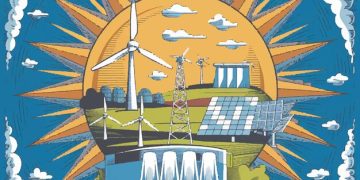Renewable Energy Grants & Incentives: Your 2025 Funding Guide

Renewable Energy Grants and Incentives: A 2025 Guide to Funding Your Project provides a comprehensive overview of available funding opportunities, eligibility criteria, application processes, and emerging trends in renewable energy financing for projects in the United States.
Navigating the world of funding for renewable energy projects can feel overwhelming. However, with the right knowledge, you can access significant financial support to bring your green initiatives to life. This guide, Renewable Energy Grants and Incentives: A 2025 Guide to Funding Your Project, is designed to help you understand and leverage the opportunities available in the United States.
Understanding Renewable Energy Incentives in 2025
The landscape of renewable energy incentives is constantly evolving. In 2025, several key factors influence the availability and structure of grants and incentives designed to promote sustainable energy development. These include federal policies, state-level initiatives, and advancements in renewable energy technology.
Federal Tax Credits and Grants
The federal government plays a crucial role in promoting renewable energy through various tax credits and grants. These incentives aim to reduce the initial costs of implementing renewable energy systems and encourage broader adoption.
- Investment Tax Credit (ITC): Provides a tax credit for a percentage of the cost of new renewable energy systems, such as solar, wind, and geothermal.
- Production Tax Credit (PTC): Offers a tax credit based on the kilowatt-hours (kWh) of electricity generated by qualified renewable energy facilities.
- Rural Energy for America Program (REAP): Supports renewable energy projects and energy efficiency improvements for agricultural producers and rural small businesses.
State-Level Renewable Energy Programs
Many states have implemented their own renewable energy programs to supplement federal efforts. These programs often include grants, rebates, and tax incentives tailored to the specific energy needs and resources of the state.
States like California, New York, and Massachusetts have particularly robust renewable energy incentive programs, offering a range of financial support for projects of all sizes. These state-level initiatives are essential for driving the growth of renewable energy across the country.

Overall, understanding the interplay between federal and state incentives is crucial for maximizing the financial benefits of your renewable energy project. Keeping abreast of policy changes and program updates will ensure you can leverage the most advantageous opportunities available in 2025.
Eligibility Criteria for Renewable Energy Grants
Before applying for renewable energy grants, it’s essential to understand the eligibility requirements set by the funding agencies. These criteria ensure that the grants are awarded to projects that align with the program’s objectives and have the potential for significant impact.
Project Type and Size
Eligibility often depends on the type and size of the renewable energy project. Some grants are specifically designed for residential solar installations, while others target larger-scale commercial or community projects.
- Residential Projects: Typically include solar panel installations, small wind turbines, and geothermal heat pumps for individual homes.
- Commercial Projects: Encompass larger solar arrays, wind farms, and biomass energy systems for businesses and organizations.
- Community Projects: Focus on renewable energy solutions that benefit multiple households or a specific community, such as shared solar gardens or district heating systems.
Applicant Qualifications
The qualifications of the applicant also play a significant role in determining eligibility. Grants may have specific requirements regarding the applicant’s legal status, financial stability, and technical expertise.
Non-profit organizations, educational institutions, and government entities may have access to grant programs that are not available to private companies or individuals. Demonstrating a clear understanding of renewable energy technologies and project management is often a key factor in the evaluation process.

In conclusion, carefully reviewing the eligibility criteria for each grant program is essential to ensure your project aligns with the requirements. Taking the time to understand these qualifications will increase your chances of securing funding and successfully implementing your renewable energy initiative.
Navigating the Grant Application Process
Applying for renewable energy grants can be a complex process, requiring meticulous preparation and attention to detail. Understanding each step involved will increase your chances of submitting a successful application.
Researching Available Grants
The first step is to thoroughly research the available grant programs that align with your project’s goals and eligibility requirements. Online databases, government websites, and industry associations are valuable resources for finding potential funding opportunities.
Preparing a Comprehensive Proposal
A well-prepared proposal is essential for convincing the grant reviewers of the value and feasibility of your project. The proposal should clearly outline the project’s objectives, methodology, budget, and expected outcomes.
- Executive Summary: A brief overview of the project and its potential impact.
- Project Description: A detailed explanation of the project’s goals, activities, and timeline.
- Budget: A comprehensive breakdown of the project’s costs, including equipment, labor, and other expenses.
Highlighting the project’s environmental and economic benefits, as well as its alignment with the funding agency’s priorities, will strengthen your proposal. Seeking feedback from renewable energy experts or grant writing consultants can also help improve the quality of your application.
In summary, mastering the grant application process requires diligent research, meticulous preparation, and a compelling proposal that showcases the value and potential of your renewable energy project.
Emerging Trends in Renewable Energy Financing
The renewable energy sector is dynamic, and financing mechanisms are evolving to meet the changing needs of the industry. Staying informed about emerging trends can help you access new funding opportunities and structure your projects for success.
Green Bonds and Sustainable Investing
Green bonds are gaining popularity as a way to finance environmentally friendly projects. These bonds are specifically earmarked for investments in renewable energy, energy efficiency, and other sustainable initiatives.
Community Solar and Crowdfunding
Community solar projects allow multiple households or businesses to share the benefits of a single solar installation. Crowdfunding platforms are also emerging as a way to raise capital for small-scale renewable energy projects.
These innovative financing models are expanding access to renewable energy for individuals and communities that may not have the resources to invest in their own systems. They also promote community engagement and raise awareness about the benefits of renewable energy.
Overall, embracing these emerging trends in renewable energy financing can open new avenues for funding your projects and contribute to the growth of the sustainable energy sector. Being proactive and exploring diverse financing options will position you for success in the evolving renewable energy landscape.
Case Studies of Successful Grant-Funded Projects
Examining real-world examples of successful grant-funded renewable energy projects can provide valuable insights and inspiration for your own initiatives. These case studies demonstrate the impact of grants in driving innovation and expanding access to clean energy.
Community Solar Project in Rural Iowa
A community solar project in rural Iowa received a grant from the USDA’s Rural Energy for America Program (REAP). The project installed a 1-megawatt solar array that provides clean energy to over 200 households in the community.
Wind Energy Project on Tribal Lands
A wind energy project on tribal lands in South Dakota received funding from the Department of Energy’s Tribal Energy Program. The project installed a 2.5-megawatt wind turbine that generates electricity for the tribal government and local businesses.
These case studies illustrate the transformative impact of grants in supporting renewable energy projects that benefit communities and drive economic development. They also highlight the importance of partnerships and collaboration in achieving success.
In conclusion, studying these successful grant-funded projects can provide valuable lessons and inspire new approaches to renewable energy development. By learning from these examples, you can increase your chances of securing funding and implementing impactful projects in your own community.
| Key Aspect | Brief Description |
|---|---|
| 💡 Federal Tax Credits | ITCs and PTCs reduce renewable energy system costs. |
| 🌱 State Programs | Grants, rebates, and tax incentives vary by state. |
| 💰 Eligibility | Project type, size, and applicant qualifications. |
| 💸 Green Bonds | Financing for environmentally friendly projects. |
FAQ
▼
The primary federal incentives include the Investment Tax Credit (ITC) and the Production Tax Credit (PTC). These offer tax benefits for investing in or producing renewable energy.
▼
Check your state’s energy office website, or use the DSIRE (Database of State Incentives for Renewables & Efficiency) database for detailed information.
▼
Yes, many grant programs are specifically designed for non-profit organizations, educational institutions, and government entities engaged in renewable projects.
▼
Green bonds are financial instruments used to fund projects with environmental benefits, including renewable energy. They direct capital toward sustainable initiatives.
▼
A strong proposal clearly outlines project objectives, methodology, budget, and expected outcomes, demonstrating alignment with the funder’s priorities.
Conclusion
Securing funding for renewable energy projects requires a thorough understanding of available grants and incentives, eligibility criteria, and application processes. By staying informed about emerging trends and learning from successful case studies, you can increase your chances of obtaining financial support and contributing to a sustainable energy future.





